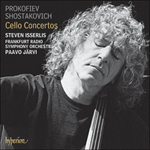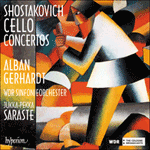
Welcome to Hyperion Records, an independent British classical label devoted to presenting high-quality recordings of music of all styles and from all periods from the twelfth century to the twenty-first.
Hyperion offers both CDs, and downloads in a number of formats. The site is also available in several languages.
Please use the dropdown buttons to set your preferred options, or use the checkbox to accept the defaults.

It may be thought initially that by being in four movements the concerto shows affinities to the preceding violin concerto and tenth and eleventh symphonies, but the work’s unique qualities immediately disabuse us of such considerations—amongst which is the orchestral make-up: double wind, timpani, celeste and strings, the only brass instrument required being a quasi-concertante part for solo horn, this last element almost in the manner of Carl Nielsen’s wind concertos. The violin concerto and both symphonies all begin with long slow movements, but the cello concerto begins with a fast, pithy four-note theme (marked piano) from the soloist, answered by a brief military tattoo from the orchestra. No previous cello concerto had ever opened like this, and the music’s fast, nervous pulse never slackens in this buoyant and colourful movement, full of subtle surprises in terms of rhythm and the dramatic juxtaposition of solo horn against the cellist, who plays almost continuously throughout.
The slow moderato movement follows, in the opposite tonality (A minor) to the ‘home’ key of E flat major. This opens with a lyrical extended paragraph, in great contrast to the urgency of the preceding movement. It is shaped in three broad sections, the second of which developmentally echoes the first; the third prepares, by way of some imaginatively reflective and extended high harmonic writing for the soloist, for the amazing third movement. This is nothing less than a full-scale cadenza for the soloist, which may well be the first time such a separate movement appears in concerto history, although structurally this profoundly difficult oration was presaged in the cadenza of the first violin concerto (likewise joining slow movement and finale). In the cello concerto, Shostakovich similarly exhibits a growth from ‘darkness to light’, now extended over a far longer time-scale. As Alexander Ivashkin noted, the cadenza’s developmental function, in the form of the complete concerto’s texture and pyrotechnics, may owe—as Shostakovich admitted on several occasions—something to Prokofiev’s Symphony-Concerto, but it speaks to us solely through Shostakovich’s own musical language.
The finale returns to the rhythmic impetus of the first movement, if not to its nervous urgency. Shostakovich cunningly builds a superbly controlled increase of tension, at the summit of which the opening pithy four-note theme returns, now on the horn, urging the rest of the orchestra to join in as the cello powerfully reinforces E flat major to conclude the concerto in a surge of almost unstoppable power.
from notes by Robert Matthew-Walker © 2020
On pourrait penser de prime abord qu’avec ses quatre mouvements, ce concerto présente des affinités avec le concerto pour violon qui l’a précédé et avec les dixième et onzième symphonies; mais les caractéristiques spécifiques de cette œuvre nous font d’emblée changer d’avis— notamment l’effectif orchestral: vents par deux, timbales, célesta et cordes, le seul instrument de la famille des cuivres étant un cor qui se voit confier une partie solo quasi concertante, un peu à la manière des concertos pour instruments à vent de Carl Nielsen. Le Concerto pour violon nº 1 et les deux symphonies commencent tous par de longs mouvements lents, mais le Concerto pour violoncelle nº 1 débute sur un thème de quatre notes (marqué piano) du soliste, rapide et concis, auquel répond une brève sonnerie militaire de l’orchestre. Aucun concerto pour violoncelle antérieur n’avait débuté ainsi, et la pulsation rapide et nerveuse de la musique ne se détend jamais tout au long de ce mouvement plein d’entrain et haut en couleur, regorgeant de subtiles surprises en termes de rythme et de juxtaposition dramatique du cor solo et du violoncelliste, qui joue pratiquement sans interruption.
Vient ensuite le mouvement lent moderato, dans la tonalité opposée (la mineur) de la tonalité «d’origine» de mi bémol majeur. Il commence par un très long paragraphe lyrique, qui contraste beaucoup avec l’urgence du mouvement précédent. Il se compose de trois larges sections, dont la deuxième rappelle la première sur le plan du développement; la troisième prépare l’étonnant troisième mouvement, par une riche écriture harmonique de la partie soliste pleine de détails et d’une imagination réfléchie; ce n’est rien moins qu’une véritable cadence pour le soliste, et c’est peut-être la première fois qu’un tel mouvement isolé fait son apparition dans l’histoire du concerto, même si, sur le plan structurel, on pouvait trouver les prémices de ce discours solennel d’une profonde difficulté dans la cadence du premier concerto pour violon (qui relie de même le mouvement lent au finale). Dans le concerto pour violoncelle, Chostakovitch crée de la même façon un passage de «l’obscurité à la lumière», maintenant développé sur une bien plus longue durée. Comme l’a remarqué Alexandre Ivachkine, la fonction développementale de la cadence, qui s’inscrit dans la texture et le feu d’artifice de l’ensemble du concerto, doit peut-être quelque chose—ce que Chostakovitch admit en plusieurs circonstances—à la Symphonie-Concerto de Prokofiev, mais elle nous parle uniquement au travers du propre langage musical de Chostakovitch.
Le finale revient à l’élan rythmique du premier mouvement, sinon à son urgence nerveuse. Chostakovitch fait astucieusement monter la tension de manière merveilleusement contrôlée vers un sommet où revient le thème initial concis de quatre notes, maintenant au cor, exhortant le reste de l’orchestre à se joindre à lui lorsque le violoncelle redonne toute sa vigueur à la tonalité de mi bémol majeur pour conclure le concerto dans un accès de puissance presque irrésistible.
Passé une introduction expressive, le mouvement lent propose trois thèmes contrastifs: une promenade consternée le long d’une route sans fin; une lamentation sincère; un chant innocent, presque comique, qui vire par trop vite à l’horriblement sinistre pour culminer en une version déchirante, aux violons avec sourdines—tels des prisonniers hurlant derrière une vitre. Pour une fois, le troisième mouvement se compose tout entier d’une cadence solo; elle est en deux parties, la première ruminant les thèmes du mouvement lent, la seconde faisant un vigoureux pont avec le finale. Là, un thème cruel, au pas lourd, précède une danse frénétique à 3/8 qui, à son tour, nous amène au retour du motif liminaire du concerto. Celui-ci, amalgamé au thème principal du finale, débouche sur une folle conflagration qui nous entraîne irrésistiblement à la conclusion de l’œuvre—certainement la fin la plus passionnante jamais entendue dans un concerto pour violoncelle.
extrait des notes rédigées par Robert Matthew-Walker © 2020
Français: Marie-Stella Pâris
Angesichts der Viersätzigkeit des Konzerts könnte man annehmen, es zeigte Ähnlichkeiten mit dem zehn Jahre älteren Violinkonzert oder mit den Sinfonien Nr. 10 und 11. Doch straft das Konzert in seiner ganzen Eigenart solche Spekulationen Lügen—schon in der Orchesterbesetzung: Neben das doppelte Holz, Pauken, Celesta und Streicher tritt als einziger Blechbläser ein einziges Horn, gleichsam als weiteres Soloinstrument, in der Art vergleichbar den Bläserkonzerten von Carl Nielsen. Sowohl das Violinkonzert als auch die beiden Sinfonien beginnen mit langsamen Sätzen, das Cellokonzert dagegen mit einem raschen und markigen viertönigen Thema des Solisten im piano, auf welches das Orchester mit einem kurzen, militärischen Trommelrhythmus antwortet. Kein Cellokonzert hatte je so begonnen. Der rasche, nervöse Tritt dieses launigen und abwechslungsreichen Satzes lässt keinen Augenblick nach; die Musik steckt voller subtiler Überraschungen im Rhythmischen wie im dramatischen Gegeneinander von Solohorn und Cello-Solist, der fast pausenlos beschäftigt ist.
Es folgt das langsame Moderato in a-Moll, der komplementären Tonart zur Haupttonart Es-Dur. Der Satz beginnt, in scharfem Kontrast zum Drängen des vorangegangenen, mit einem längeren lyrischen Abschnitt. Insgesamt besteht er aus drei Großabschnitten; im durchführungshaften zweiten hallt der erste nach. Der dritte dagegen bereitet mit seiner fantasievoll-nachdenklichen Sololinie und ausgedehnten hohen Flageolett-Partien den dritten Satz vor. Dieses erstaunliche Stück ist nichts anderes als eine ausgewachsene Solokadenz. In der Geschichte des Solokonzerts dürfte es hier zum ersten Mal geschehen, dass sie einen ganzen, eigenen Satz für sich beansprucht; dabei hat diese äußerst schwierige, gleichsam sprechende Musik einen formalen Vorläufer in der Kadenz des ersten Violinkonzerts, die ebenfalls vom langsamen Satz in das Finale überleitet. Ähnlich wie dort lässt Schostakowitsch den Solisten den Weg „aus Nacht zum Licht“ zurücklegen, der sich hier allerdings weitaus länger hinzieht. Von Alexander Iwaschkin stammte die Beobachtung, dass die Rolle der Kadenz in der Materialentwicklung, dem Aufbau und der virtuosen Haltung des Werks ein Vorbild in Prokofjews Sinfonischem Konzert hat, wie Schostakowitsch auch gelegentlich einräumte. Doch der Tonfall dieses Konzerts ist unverwechselbar der Schostakowitschs.
Das Finale kehrt zum rhythmischen Schwung des Kopfsatzes zurück, allerding ohne dessen nervöses Drängen. Auf raffinierte Weise lässt Schostakowitsch hier die Spannung wohlkalkuliert ansteigen, bis auf dem Höhepunkt das prägnante Viertonthema vom Beginn wiederkehrt, nun im Horn. Es drängt das übrige Orchester dazu, einzustimmen, während das Cello nachdrücklich und immer wieder auf Es-Dur beharrt und das Konzert in einem nahezu unaufhaltsamen Aufbäumen zu Ende führt.
Der langsame Satz präsentiert nach einer ausdrucksvollen Einleitung drei kontrastierende Themen. Das erste ist ein verzweifelter Marsch entlang einer endlosen Straße, das zweite ein tiefempfundenes Lamento, und das dritte ein unschuldiges, fast komisches Lied, dass nur allzu bald schrecklich sinister wird und in einer gequälten Version mit gedämpften Violinen kulminiert—etwa wie hinter einer Glaswand schreiende Gefangene. Der gesamte dritte Satz besteht ungewöhnlicherweise aus einer Solokadenz; diese ist zweiteilig gestaltet, wobei der erste Teil über die Themen des langsamen Satzes nachsinnt und der zweite eine energische Brücke zum Finale bildet. Hier folgt auf ein grausames, umherstampfendes Thema ein Tanz in 3/8. Dieses frenetische Thema leitet in eine Wiederholung des Anfangsmotivs des Konzerts hinüber, verbindet sich mit dem Hauptthema des Finales, woraufhin das Ganze in Flammen aufgeht und unaufhaltsam dem Ende des Werks entgegensteuert—sicherlich der aufregendste Schluss aller Cellokonzerte.
aus dem Begleittext von Robert Matthew-Walker © 2020
Deutsch: Friedrich Sprondel
 Prokofiev & Shostakovich: Cello Concertos Prokofiev & Shostakovich: Cello ConcertosElectrifying new recordings of Prokofiev and Shostakovich Cello Concertos—revolutionary works here freshly imbued with fire by a commanding Steven Isserlis.» More |
 Shostakovich: Cello Concertos Shostakovich: Cello ConcertosExtraordinary accounts from Alban Gerhardt of two of the twentieth century’s greatest cello concertos.» More |

